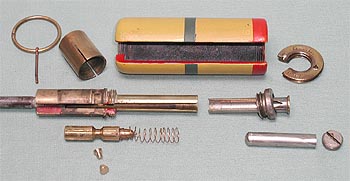


Inset is the parts detail from the No.24 grenade for reference. Note the striker geometry has changed. This allowed the base plug to be reduced in length by half, saving that always most strategic of war materials, copper. The set-back safety collar is a bit smaller and the safety pin now goes thought that and the base piece. The detonator housing is also simplified to a zinc and copper swaged assembly.
The parts count here is 12, down from 15 with very few precision machined parts.
The body is marked with:"No.35" “E" “T”, and the top ring and plunger are stamped “G.T.L”..
The red color is probably copied from the French (and Germans) signifying a practice round. The common practice was to use live fuze/detonator assemblies without the H.E. filler. Often this meant the grenade body would still burst during use, but there would be no significant fragmentation effect. Seems the Germans were the first to make practice grenades with holes in the bodies to vent the pressure. It seems odd that it took the rest of the world until W.W.II to figure that his was a good idea as well.